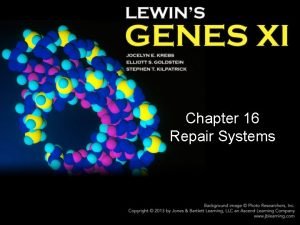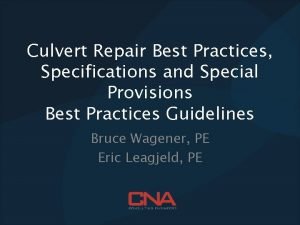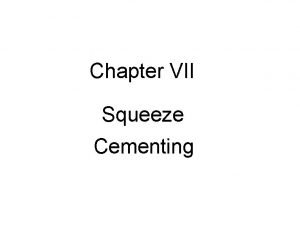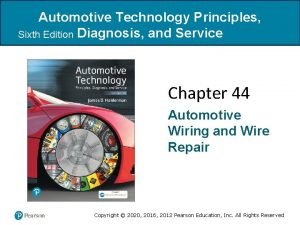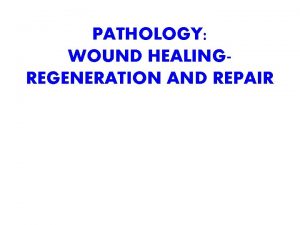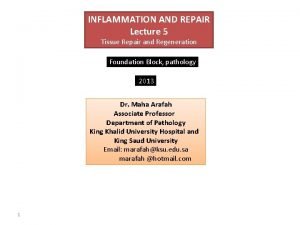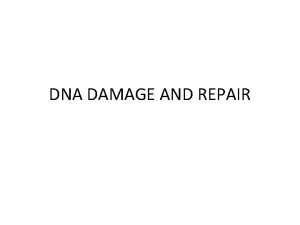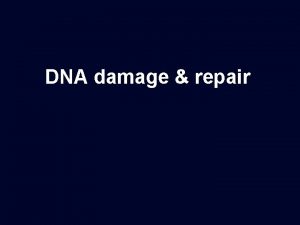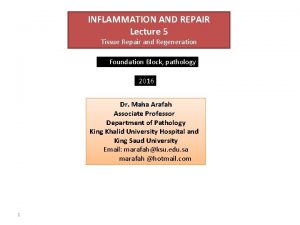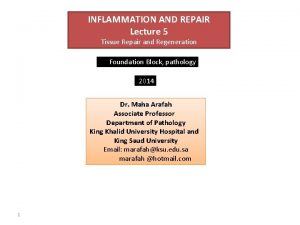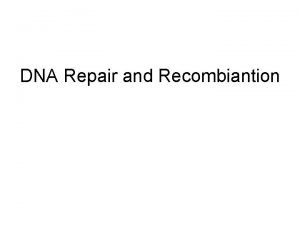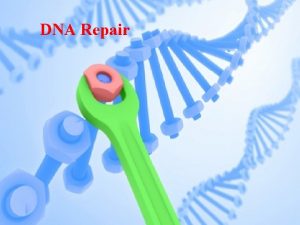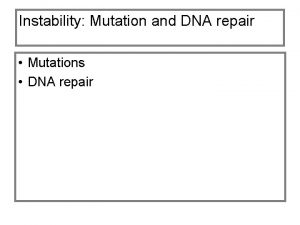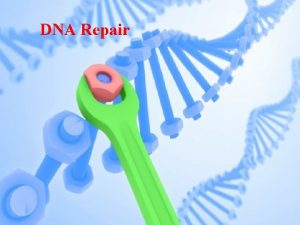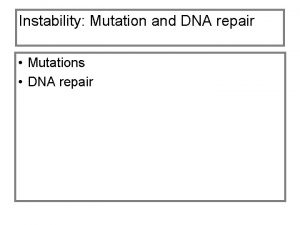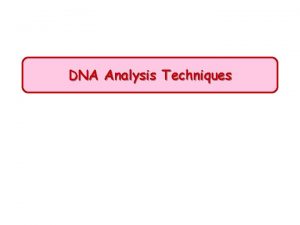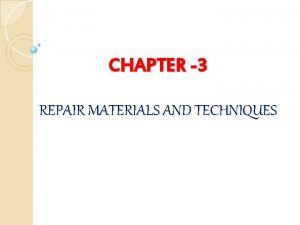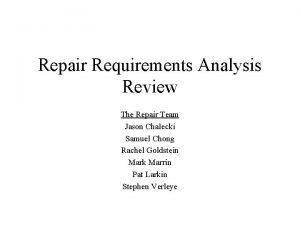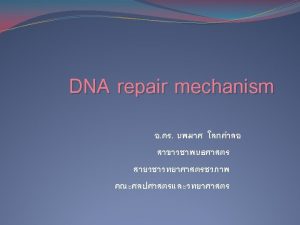CHAPTER V Techniques For Repair And Repair Of

























































- Slides: 57

CHAPTER V Techniques For Repair And Repair Of Structures

This section includes: Introduction ü Guniting ü Shortcreting ü Repair for cracks ü Shoring and underpinning ü Repairs to overcome low member strength ü

Introduction: The success of repair activity depends on the identification of the root cause of the deterioration of the concrete structures. If this cause is properly identified, satisfactory repairs can be done for the improvement of strength and durability, thus extending the life of the structure, is not difficult to achieve.

General procedure in the repair of distressed concrete structure: Support the structural members properly as required. Remove all cracked, spalled and loose concrete. Clean the exposed concrete surfaces and steel reinforcement. Provide additional reinforcing bars, if the loss in reinforcement is more than 10% Apply shortcreting/polymer concrete for patch repair work and grouting for porous/honeycombed concrete. Apply protective coatings over the exposed/repaired surface.

Gunite & Shortcrete

Guniting cement, aggregates and water. and conveyed through a hose pipe with the help of compressed air. separate brings line A water pipe under pressure water the and cement aggregate mix are passed through and intimately mixed in a special manifold and then projected at high velocity to the surface being repaired.




Shortcreting

Applications : Shortcrete has been used to repair : canal and spillway linings and walls the faces of dams, tunnel linings highway bridges and tunnels deteriorating natural rock walls and earthen slopes to thicken and strengthen existing concrete surfaces

REPAIR FOR CRACKS

Repair for cracks: i) Stitching ii) Routing and sealing iii) Resin injection iv) Dry packing v) Polymer impregnation vi) Vacuum impregnation vii) Autogenous healing viii) Flexible sealing ix) Drilling and plugging x) Bandaging


STITCHING v In this technique, the crack is bridged with U-shaped metal units called stitching dogs before being repaired with a rigid resin material. v A non- shrink grout or an epoxy resin based adhesive should be used to anchor the legs of the dogs. v Stitching is suitable when tensile strength must be re established across major cracks. v Stitching dogs should be of variable length and orientation.


BENEFITS OF CRACKED STITCHING �Quick, simple, effective and permanent. �The grout combination provides an excellent bond within the substrate. �Masonry remains flexible enough to accommodate natural building movement. �Non-disruptive structural stabilization with no additional stress

ROUTING AND SEALING Ø This is the simplest and most common method of crack repair. Ø It can be executed with relatively unskilled labor and can be used to seal both fine pattern cracks and larger isolated cracks. Ø This involves enlarging the crack along its exposed face and sealing it with crack fillers. Ø Care should be taken to ensure that the entire crack is routed and sealed.


RESIN INJECTION Ø Epoxy resins are usually selected for crack injection because of their high mechanical strength and resistance to most chemical environments encountered by concrete. Ø Epoxies are rigid and not suitable for active cracks. Ø This method is used to restore structural soundness of members where cracks are dormant or can be prevented from further movements.


SHORING

INTRODUCTION Definition �It is the method of providing temporary support (shores) to an unsafe structure. Types of Shoring �Horizontal shoring or flying shoring �Vertical shoring or dead shoring �Inclined Shoring or flying shoring

Horizontal shoring �It consists of �Horizontal beam or strut �Wall plates �Cleats �Straining beams �Used to support two adjacent buildings.

Horizontal shoring

Single Flying Shoring

Double Flying Shoring

Vertical shoring �It consists of �Dead shores �Sole plates �Needles �Props �Used for rebuilding of walls.

Vertical shoring

Dead or Vertical Shoring

Inclined Shoring �It consists of �Rackers �Needles �Cleats �Braces �Sole plate �Used to strengthen a wall.


Inclined or Raking Shoring (unsymmetrical)


UNDERPINNING

DEFINITION

PURPOSE OF UNDERPINNING • To obtain additional foundation capacity • To modify the existing foundation system • To create new foundations through which the existing load may be wholly or partially transferred into deeper soil • To arrest the excessive settlement • To improve the future performance of the existing foundations

WHEN UNDERPINING IS REQUIRED? Underpinning is required when: • adjacent to an existing building. • Change in the use of structure • The properties of the soil supporting the foundation may have changed or was mischaracterized during planning. • ground subsidence or instability of the super structure

METHODS USED FOR UNDERPINNING • � • • • Pit Underpinning Push Piers System Helical Pier System Pile Underpinning Other Methods • Chemical Grouting • Microfine Grouting � Micropiles

PIT UNDERPINNING


HELICAL PIER SYSTEM Damaged Foundation Repaired Foundation 42


DEFLECTION Equations for calculating Dinst for common cases


DAMAGE DUE TO FIRE



Fire Damage Repairs �Timber structures may be repaired with new timbers or composites of steel and timber members � Steel structures are normally repaired with steel. �Both concrete and masonry structural elements are frequently repaired with fiber reinforced polymers (FRP). �Concrete structures are occasionally repaired with shortcrete.

Repair of leakage structure





1. Case study of using complex reinforced structure to repair mountain road landslide in Taiwan Steep collapsed interface like planar sliding damage

After construction

THANK YOU
 Nucleotide excision repair
Nucleotide excision repair Base excision repair vs mismatch repair
Base excision repair vs mismatch repair Culvert repair techniques
Culvert repair techniques Cement squeeze job procedure
Cement squeeze job procedure Chapter 81 brake system diagnosis service and repair
Chapter 81 brake system diagnosis service and repair Chapter 76 suspension system diagnosis and repair answers
Chapter 76 suspension system diagnosis and repair answers Chapter 42 gasoline injection diagnosis and repair
Chapter 42 gasoline injection diagnosis and repair Chapter 44 automotive wiring and wire repair
Chapter 44 automotive wiring and wire repair Fonctions et solutions techniques
Fonctions et solutions techniques Kontinuitetshantering
Kontinuitetshantering Typiska novell drag
Typiska novell drag Nationell inriktning för artificiell intelligens
Nationell inriktning för artificiell intelligens Ekologiskt fotavtryck
Ekologiskt fotavtryck Shingelfrisyren
Shingelfrisyren En lathund för arbete med kontinuitetshantering
En lathund för arbete med kontinuitetshantering Personalliggare bygg undantag
Personalliggare bygg undantag Personlig tidbok
Personlig tidbok A gastrica
A gastrica Densitet vatten
Densitet vatten Datorkunskap för nybörjare
Datorkunskap för nybörjare Tack för att ni lyssnade bild
Tack för att ni lyssnade bild Hur skriver man en tes
Hur skriver man en tes Delegerande ledarskap
Delegerande ledarskap Nyckelkompetenser för livslångt lärande
Nyckelkompetenser för livslångt lärande Påbyggnader för flakfordon
Påbyggnader för flakfordon Vätsketryck formel
Vätsketryck formel Publik sektor
Publik sektor Kyssande vind analys
Kyssande vind analys Presentera för publik crossboss
Presentera för publik crossboss Teckenspråk minoritetsspråk argument
Teckenspråk minoritetsspråk argument Vem räknas som jude
Vem räknas som jude Treserva lathund
Treserva lathund Epiteltyper
Epiteltyper Bästa kameran för astrofoto
Bästa kameran för astrofoto Cks
Cks Programskede byggprocessen
Programskede byggprocessen Mat för idrottare
Mat för idrottare Verktyg för automatisering av utbetalningar
Verktyg för automatisering av utbetalningar Rutin för avvikelsehantering
Rutin för avvikelsehantering Smärtskolan kunskap för livet
Smärtskolan kunskap för livet Ministerstyre för och nackdelar
Ministerstyre för och nackdelar Tack för att ni har lyssnat
Tack för att ni har lyssnat Referatmarkering
Referatmarkering Redogör för vad psykologi är
Redogör för vad psykologi är Stål för stötfångarsystem
Stål för stötfångarsystem Tack för att ni har lyssnat
Tack för att ni har lyssnat Borra hål för knoppar
Borra hål för knoppar Orubbliga rättigheter
Orubbliga rättigheter Variansen formel
Variansen formel Tack för att ni har lyssnat
Tack för att ni har lyssnat Rita perspektiv
Rita perspektiv Ledningssystem för verksamhetsinformation
Ledningssystem för verksamhetsinformation Tobinskatten för och nackdelar
Tobinskatten för och nackdelar Toppslätskivling dos
Toppslätskivling dos Gibbs reflekterande cykel
Gibbs reflekterande cykel Egg för emanuel
Egg för emanuel Elektronik för barn
Elektronik för barn Antikt plagg
Antikt plagg

